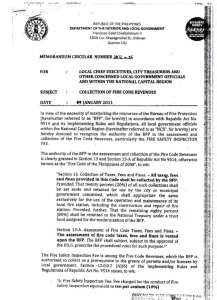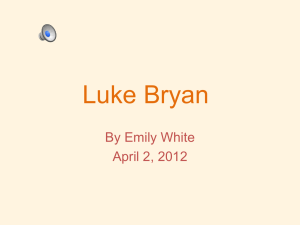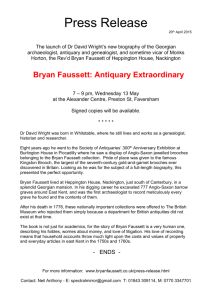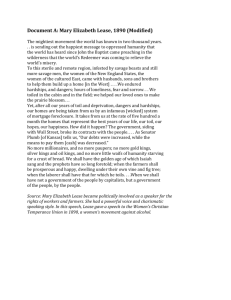Power Point 11/10-12 (E1 Version)
advertisement
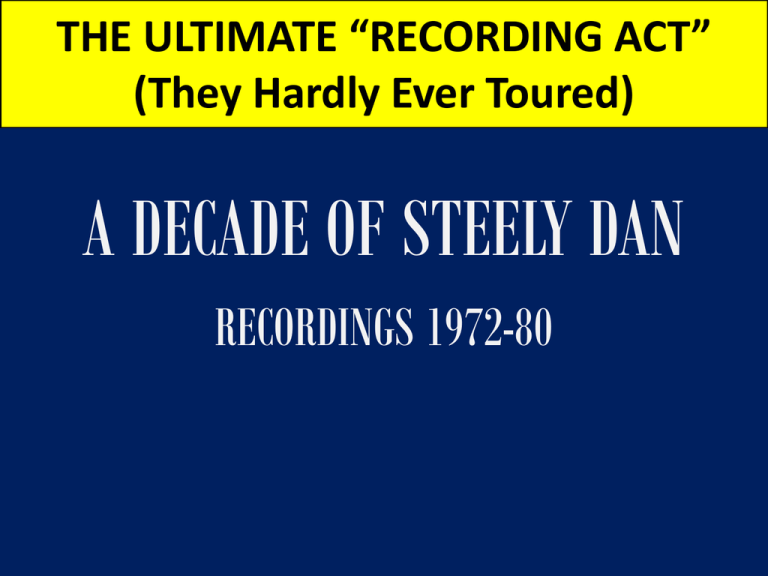
THE ULTIMATE “RECORDING ACT” (They Hardly Ever Toured) A DECADE OF STEELY DAN RECORDINGS 1972-80 Duty to Disclose DQ84: Ordinary Sellers v. Comm’l Sellers v. Agents/Brokers • Strawn distinguishes on-site & off-site defects – All sellers responsible for on-site (e.g., polluted water supply) – Only comm’l sellers responsible for off-site – Rev Prob 5B (Fri): Is noise an on-site OR off-site defect? • Sellers v. Agents/Brokers: I won’t test Duty to Disclose Defects DQ85-88 (Wheat) Duty to Disclose Policy Q: What Should Count as a Defect? • Some states: Statutory disclosure list – Usually makes it easy to identify “defects” – But see P409: Calif. Statute requires disclosure of “neighborhood noise problems or other nuisances.” Duty to Disclose Policy Q: What Should Count as a Defect? • Some states: Statutory disclosure list • Materiality also provides limit (no need to disclose if insufficient effect on value). Exact test varies: – Most states require that the fact be simply “material” to value (= “relevant”) – WVa stricter: “substantially affect” value/habitability DQ 85: Why might a state choose a more strict requirement like this? Is it a good idea? Duty to Disclose Policy Q: What Should Count as a Defect? • Some states: Statutory disclosure list • Materiality also provides limit • Can argue some things shouldn’t count as matter of public policy even if tests all met. (Like preclusion issues for nuisance) Duty to Disclose Policy Q: What Should Count as a Defect? What shouldn’t count as “defect” as matter of public policy even if tests all met? Two related policy concerns: 1. Are there issues where we don’t think the seller should bear the burden of disclosure? 2. Are there issues for which disclosure itself is a bad idea? Duty to Disclose Policy Q: What Should Count as a Defect? 1. Issues where we don’t think the seller should bear the burden of disclosure . • Could draw line at on-site v. off-site • Could draw line at subjective v. objective: (E.g., quality of local school district) • Could draw line where seller has no information advantage over buyer (e.g., Zoning: Compare info on laws to info on particular decisions) Duty to Disclose Policy Q: What Should Count as a Defect? 2. Issues where disclosure is a bad idea. • Maybe effect on market value is irrational • Maybe possible harm/stigma/privacy issues • Examples: Early AIDS cases; Group homes for persons with disabilities • “Stigma statutes” provide lists of issues that need not be disclosed to avoid undue harm to value Duty to Disclose Policy Q: What Should Count as a Defect? 2. Issues where disclosure is a bad idea. • “Stigma statutes” provide lists of issues that need not be disclosed to avoid undue harm to value: E.g., Fl. Stat. 689.25(1) (a) The fact that an occupant of real property is infected or has been infected with human immunodeficiency virus or diagnosed with acquired immune deficiency syndrome is not a material fact that must be disclosed in a real estate transaction. (b) The fact that a property was, or was at any time suspected to have been, the site of a homicide, suicide, or death is not a material fact that must be disclosed in a real estate transaction. DQ87: Strawn P411: No duty to disclose “transient social conditions” MEANS? DQ87: Strawn P411: No duty to disclose “transient social conditions” What does it mean two sentences later when it says “we root in the land the duty to disclose offsite conditions”? DQ87: Strawn P411: No duty to disclose “transient social conditions” EXAMPLES • Changing nature of neighborhood • School in decline • Group home nearby MUST DISCLOSE • Landfill • Planned superhighway; • Office complex approved nearby CAN YOU ARTICULATE DIFFERENCE? What Should Count as a Defect: DQ86: Hypotheticals Arguments from Policy & Strawn Language a) Violent crime in the house itself. – Why relevant? – Should seller have to disclose? What Should Count as a Defect: DQ86: Hypotheticals Arguments from Policy & Strawn Language a) Violent crime in the house itself. b) Violent crime in a neighboring house. – Reasons to treat differently from (a)? What Should Count as a Defect: DQ86: Hypotheticals Arguments from Policy & Strawn Language (f) Physical contact with some of the plants in the yard gives many people rashes or blisters. What Should Count as a Defect: DQ86: Hypotheticals Arguments from Policy & Strawn Language (f) Physical contact with some of the plants in the yard gives many people rashes or blisters. NOTE TIE TO NUISANCE ISSUE Duty to Disclose Defects DQ88: Waivable? (Check State) • Casebook: Most jurisdictions don’t allow waiver re fraud • Johnson (FL) suggests can’t waive duty to disclose • Stambovsky (S115): Disclaimer in this contract irrelevant – Only covers physical defects (not reputation) • Note cute contract interpretation point: • IF this is a physical defect, then premises not “vacant” – Ct. says can’t disclaim if peculiarly within knowledge of seller. Duty to Disclose Defects DQ88: Waivable? Suppose a court allowed residential buyers to waive the duty to disclose in some circumstances. • What facts should be relevant to this determination? • What circumstances would provide the best case for allowing waiver? Duty to Disclose Defects DQ88: Final Qs (For You!) • What is best approach to problem? – Caveat emptor v. Disclosure form v. Lawsuit – What is best legal test? • Relevant policy debate – Protecting homebuyers v. requiring homebuyers to act diligently (inspect/ask Qs). – Are policy arguments in the cases convincing? • Applicability of Duty to Disclose Rules to Landlord/ Tenant (Interesting Q; Outside Scope of Course) POP CULTURE QUIZ: NAME THAT BAND • First Billboard #1 Hit in 1958 • Won 5 Grammy Awards; Nominated for 8 Others • Won American Music Award for Best Soundtrack Album • Featured in a Major Studio Motion Picture Released in 2009 ANSWER ON FRIDAY LOGISTICS • Friday’s Class – Start with Duty to Disclose Review Problems – Finish Recording Acts – Start Easements • Housing Discrimination • Practice Midterms • Grading: 12 + 12 + 60 = 84 – Line ‘em up & draw lines NOTICE & THE RECORDING SYSTEM NOTICE (of Conflicting Property Rights) • Actual Notice: Fact Question • Constructive Notice: Generally Legal Q – Record Notice (from public records) – Inquiry Notice (facts suggesting conflicting interest) Operation of the Recording System • Every jurisd. in US has recording office • If a real property interest is transferred, normally grantee records document – Deeds, Mortgages, Easements – Court judgments; lis pendens (Nightmare) etc. • Clerks of court: “blind” recipients w date stamps • County keeps documents & notes them in indexes Purposes of Recording System • Provides public record of land titles: gov’t knows who is responsible • Secures copies of important documents • Provides notice to subsequent buyers – Can see chain of title of seller – Can see non-ownership interests (e.g., easements, other servitudes) – Gives grantees incentive to record Recording Acts: Problem Addressed • Transfer of Interest in Same Property to Two Different Grantees (OA, OB) – Can be resale of whole parcel – More frequently, transfer of partial interest (e.g., easement or mineral rights) that conflicts with later transfer of complete interest Recording Acts: Problem Addressed • Transfer of Interest in Same Property to Two Different Grantees(OA, OB) • O liable for fraud or breach of warranty – A v. B: who gets ppty rt & who just gets lawsuit? – Common law answer: 1st in time = 1st in Right, so A gets ppty right Recording Acts: Operation • Recording has no effect on rights of parties to original transaction as betw. themselves: – Unrecorded OA deed still valid – O can’t defend suit by A by saying “unrecorded” Recording Acts: Operation • Recording has no effect on rights of parties to original transaction as betw. themselves: • Protects buyers who record against other transferees – Often yields different results than 1st in time – Most jurisdictions protect later bona fide purchaser (BFP) for value against unrecorded interests BFP for VALUE: Definitions Bona Fide Purchaser = good faith • No notice of prior transaction • Status is specific to one prior transaction • Can only be true of later player BFP for VALUE: Definitions Bona Fide Purchaser = good faith What is value? (jurisdiction specific) • donees, heirs, devisees usually not prot’d • split re amount of consideration needed 3 Kinds of Recording Acts 1. Race 2. Notice 3. Race-Notice 3 Kinds of Recording Acts 1. Race – 1st to Record Wins – N.C. + La. + Del. for all interests – Some others for some specific interests 2. Notice 3. Race-Notice 3 Kinds of Recording Acts 1. Race 2. Notice – Protects BFP for Value against prior unrecorded interests regardless of when or if BFP records – About half the states (e.g. TX + FL) 3. Race-Notice 3 Kinds of Recording Acts 1. Race 2. Notice 3. Race-Notice – Protects BFP for Value against prior unrecorded interests only if BFP records 1st – About half the states (e.g. NY + CA) DQ89 featuring ALL • • • • • • Kurland, Matt Velarde, Victor Villarosa, Michael Goldbaum, Candice Schnedar, Jeff Rigby, Brett • • • • • • Caliendo, Courtney Navarrete, Ana-Sofia Liu, Tian Ryan, Mike Delsontro, Michael Gastin, Jeremy DQ89: Situation 1 OA OB (BFP) B records [O B deed] A records [O A deed] WHO WINS IN …? • RACE: • NOTICE: • RACE-NOTICE: DQ89: Situation 1 OA OB (BFP) B records [O B deed] A records [O A deed] WHO WINS IN …? • RACE: B • NOTICE: B • RACE-NOTICE: B DQ89: Situation 2 OA A records OB B records WHO WINS IN …? • RACE: • NOTICE: • RACE-NOTICE: DQ89: Situation 2 OA A records OB B records WHO WINS IN …? • RACE: A • NOTICE: A • RACE-NOTICE: A Moral of Situations 1 & 2: If you record immediately, you are always in the best position possible. DQ89: Situation 3 OA OB (NOT BFP) B records A records WHO WINS IN …? • RACE: • NOTICE: • RACE-NOTICE: DQ89: Situation 3: RACE STATUTE: PROTECTS BAD FAITH PURCHASER WHO RECORDS FIRST OA OB (NOT BFP) B records A records WHO WINS IN …? • RACE: B • NOTICE: A • RACE-NOTICE: A DQ89: Situation 4 OA OB (BFP) A records B records WHO WINS IN …? • RACE: • NOTICE: • RACE-NOTICE: DQ89: Situation 4: NOTICE STATUTE: PROTECTS BFP EVEN IF DOESN’T RECORD FIRST OA OB (BFP) A records B records WHO WINS IN …? • RACE: A • NOTICE: B • RACE-NOTICE: A DQ89: Title Search with Grantor-Grantee Indexes Purchasing from Ms. Cohen. How do you begin? DQ89: Title Search with Grantor-Grantee Indexes Purchasing from Ms. Cohen. 1. Check grantee index under Cohen going backward from present. You find record of deed: Bryan Cohen (1984). What now? DQ89: Title Search with Grantor-Grantee Indexes Purchasing from Ms. Cohen. 1. Deed: Bryan Cohen (1984). 2. Check grantee index under Bryan going backward from 1984. You find record of deed: Anderson Bryan (1969). What now? DQ89: Title Search with Grantor-Grantee Indexes Purchasing from Ms. Cohen. 1. Deed: Bryan Cohen (1984). 2. Deed: Anderson Bryan (1969). 3. Check grantee index under Anderson going backward from 1969. You find record of deed: U.S. Govt Anderson (1962). What now? DQ89: Title Search with Grantor-Grantee Indexes From Grantee Index: Check grantor index to see if Anderson conveyed any Bryan Cohen (1984). interests between 1962 and Anderson Bryan (1969). 1969. You find nothing until Anderson Bryan deed in 1969. U.S.Govt Anderson What Next? (1962) DQ89: Title Search with Grantor-Grantee Indexes From Grantee Index: Bryan Cohen (1984). Anderson Bryan (1969). U.S.Govt Anderson (1962) Anderson Bryan (1969). Check grantor index to see if Bryan conveyed any interests between 1969 and 1984. You find easement granted to Electric Co. in 1971 & nothing else until Bryan Cohen deed in 1984. What Next? DQ89: Title Search with Grantor-Grantee Indexes From Grantee Index: Bryan Cohen (1984). Anderson Bryan (1969). U.S.Govt Anderson (1962) From Grantor Index Anderson Bryan (1969). Bryan Elec. Co. (1971) (Easement) Bryan Cohen (1984). Check grantor index to see if Cohen conveyed any interests between 1984 and the present PLUS Check to see if Electric Co. released or transferred the easement. Nothing Additional. What Next? DQ89: Title Search with Grantor-Grantee Indexes From Grantee Index: Bryan Cohen (1984). Anderson Bryan (1969). U.S.Govt Anderson (1962) From Grantor Index Anderson Bryan (1969). Bryan Elec. Co. (1971) (Easement) Bryan Cohen (1984). Check all documents uncovered through index for content and references to unrecorded interests. Tract Indexes • Index transactions by location not names of parties • Much easier to use for most types of transactions • Exist almost everywhere privately; and as official public record in a few jurisdictions • Many states have rules based on grantor-grantee indexes even if public or private tract indexes exist Shelter Rule (Notice Jurisd.) OA OB (BFP) A records • In a notice jurisdiction, B wins over A as a subsequent BFP even though A recorded first • Note that for A’s recording to serve as notice to B, it must have taken place prior to the time B purchases the land. Shelter Rule (Notice Jurisd.) OA OB(BFP) A records BC Who wins A v. C? • The OA deed is recorded before C’s purchase so C is not a BFP. Shelter Rule (Notice Jurisd.) OA OB(BFP) A records BC Who wins A v. C? C is not a BFP BUT: Shelter rule: Subsequent purchaser from BFP stands in shoes of BFP and defeats prior interest – even if not BFP – unless original grantor WHY? Shelter Rule (Notice Jurisd.) OA OB (BFP) A records BC • Protects title of a BFP from recording or adverse publicity that occurs subsequent to purchase. Otherwise, B couldn’t sell, so victory over A worthless Uribe Sells Same Lot to Both Breslin and Caliendo; Flees to Cayman Islands Buyers Confused, Angry: Who Will Get the Land and Who Will Have to Chase After Uribe? Tattler Exclusive: Seller’s Friends Say Not Surprised. Shelter Rule (Notice Jurisd.) Urice Breslin Urice Caliendo (BFP) Massive Publicity on Slow News Day Caliendo Duaban (Actual Notice; Not BFP) Duaban wins over Breslin to give value to Caliendo’s interest CHAIN OF TITLE PROBLEMS Problems in way things are recorded or indexed that frustrate basic search. If significant enough: – Can mean no record notice – Can mean not “recorded” for purpose of racenotice CHAIN OF TITLE PROBLEMS: EXAMPLES (FYI; not tested) • Documents recorded out of usual order • Document refers to several lots w/o listing individually (all land owned by X) • Same person referred to by different name on later document (misspelling or name change(s)) 1948 Grant to Elizabeth Taylor Where do you look in the grantor index going forward? 1948 Grant to Elizabeth Taylor Where do you look in the grantor index? 1950 Elizabeth Taylor Hilton 1948 Grant to Elizabeth Taylor Where do you look in the grantor index? 1952 Elizabeth Taylor Hilton Wilding 1948 Grant to Elizabeth Taylor Where do you look in the grantor index? 1957: Elizabeth Taylor Hilton Wilding Todd 1948 Grant to Elizabeth Taylor Where do you look in the grantor index? 1959 Elizabeth Taylor Hilton Wilding Todd Fisher 1948 Grant to Elizabeth Taylor Where do you look in the grantor index? 1964 Elizabeth Taylor Hilton Wilding Todd Fisher Burton 1948 Grant to Elizabeth Taylor Where do you look in the grantor index? 1975 Elizabeth Taylor Hilton Wilding Todd Fisher Burton Burton 1948 Grant to Elizabeth Taylor Where do you look in the grantor index? 1976 Elizabeth Taylor Hilton Wilding Todd Fisher Burton Burton Warner 1948 Grant to Elizabeth Taylor Where do you look in the grantor index? 1991 Elizabeth Taylor Hilton Wilding Todd Fisher Burton Burton Warner Fortensky 1948 Grant to Elizabeth Taylor Where do you look in the grantor index? 2010? Elizabeth Taylor Hilton Wilding Todd Fisher Burton Burton Warner Fortensky Winters NOTICE & THE RECORDING SYSTEM: WHAT YOU NEED TO KNOW • • • • Basic Use of Grantor-Grantee Index 4 Typical Situations (S128) Shelter Rule (S129) Three Types of Notice – Actual – Record – Inquiry (including Possession as Notice) POP CULTURE QUIZ: NAME THAT BAND • First Billboard #1 Hit in 1958 • Won 5 Grammy Awards; Nominated for 8 Others • Won American Music Award for Best Soundtrack Album • Featured in a Major Studio Motion Picture Released in 2009 NAME THAT BAND

